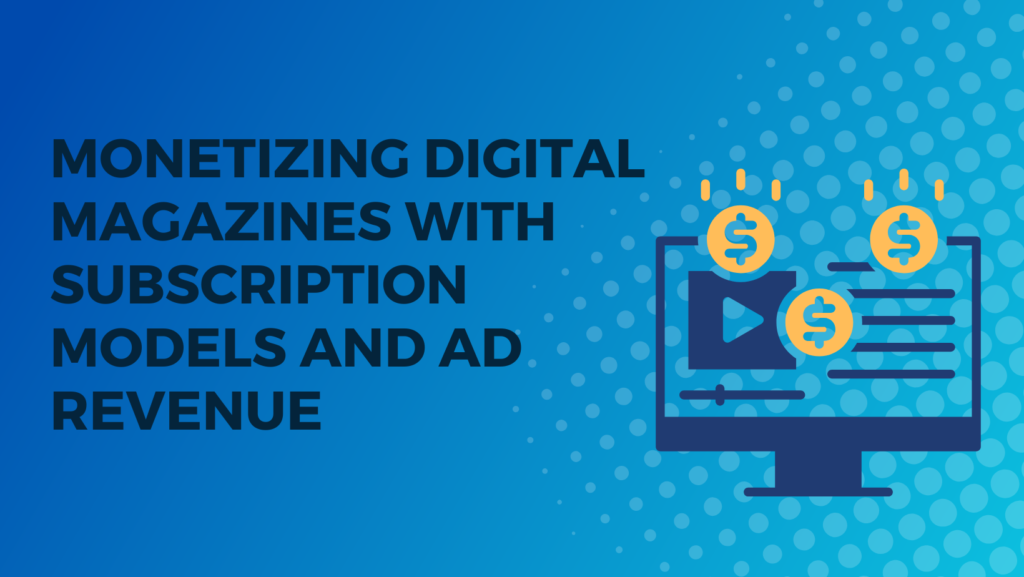
Publishers are faced with exciting monetizing opportunities, yet these also presents the challenge of identifying the most effective strategies for monetizing digital magazines. Two of the most popular models are subscription-based and ad-supported revenue streams. Each approach has its advantages and challenges, and the best choice often depends on the nature of your content and target audience. In this post, we’ll explore both models, highlighting the pros and cons of each to help you decide which monetization strategy might work best for your digital magazine.
The Subscription Model – Building a Loyal Audience
Subscription-based models are increasingly popular, particularly among digital magazines that offer high-quality, exclusive content. In this approach, readers pay a recurring fee—either monthly or annually—to access your digital magazine, which may offer premium articles, special editions, or exclusive multimedia content.
Advantages of the Subscription Model:
- Predictable Revenue Stream: One of the biggest benefits of subscription models is the predictability of income. With a steady number of subscribers, publishers can forecast revenue with greater accuracy, making it easier to plan and invest in future content.
- Loyal Audience Base: Subscriptions help build a loyal and dedicated audience who are willing to pay for content they find valuable. These readers are more likely to engage with the magazine consistently, leading to higher retention rates and longer-term brand loyalty.
- Focus on Quality Content: Subscription models often encourage publishers to focus on producing high-quality, niche, and exclusive content. Because readers are paying for a premium experience, the emphasis is on delivering value, which can lead to a stronger brand identity and reputation.
- Ad-Free Experience: Many readers are willing to pay for a subscription if it means accessing content without ads. This can enhance the user experience, making the digital magazine more enjoyable and professional, which may lead to better retention and higher subscription rates.
Challenges of the Subscription Model:
- Attracting Subscribers: Convincing readers to pay for content in a world where so much is available for free can be challenging. It often requires a robust marketing strategy and a compelling value proposition to convert casual readers into paying subscribers.
- High Content Expectations: Subscribers expect top-notch content that justifies their payment. This puts pressure on publishers to consistently produce high-quality, engaging material, which may require a significant investment of time, resources, and talent.
- Retention and Churn Rates: While subscriptions provide a steady revenue stream, maintaining that stream involves continuously engaging subscribers to minimize churn (the rate at which subscribers cancel their subscriptions). This means publishers must regularly introduce fresh content and offer incentives for long-term commitment.
Ad Revenue Model – Maximizing Reach and Engagement
The ad-supported model is another popular monetization strategy, particularly for digital magazines with a broad or rapidly growing readership. In this approach, revenue is generated through displaying ads within the digital magazine. These can be banner ads, sponsored content, or even video ads.
Advantages of the Ad Revenue Model:
- Access to a Wider Audience: Unlike the subscription model, which may limit readership to paying subscribers, the ad model allows for a broader audience since the content is typically free. This can increase traffic and reach, making it easier to attract new readers.
- Diverse Revenue Opportunities: Ad-supported magazines can explore various types of ads, such as display ads, native ads, sponsored articles, or affiliate marketing. This flexibility allows publishers to experiment with different advertising methods to maximize revenue.
- Monetizing Popular Content Quickly: Publishers using ad revenue models can capitalize on viral content or trending topics immediately. By generating ad revenue from high-traffic articles or features, they can boost earnings quickly without relying on subscription growth.
Challenges of the Ad Revenue Model:
- Ad Fatigue and Reader Experience: One of the main drawbacks of relying heavily on ads is the potential impact on user experience. Intrusive or excessive ads can lead to “ad fatigue,” causing readers to leave the site or seek out alternative, ad-free publications.
- Revenue Fluctuations: Ad revenue can be unpredictable, as it is often tied to website traffic and advertiser demand, which can fluctuate. Changes in traffic patterns, seasonal trends, or shifts in the advertising market can all impact earnings, making it difficult to forecast revenue consistently.
- Dependence on Third-Party Platforms: Many digital magazines rely on third-party ad networks like Google AdSense, which may impose specific content and design constraints. Additionally, changes in these platforms’ policies or algorithms can directly affect revenue potential, making publishers vulnerable to external factors.
Finding the Right Balance – A Hybrid Approach
While subscription and ad revenue models are effective individually, some publishers are finding success by combining both strategies in a hybrid approach. Here’s how it can work:
- Freemium Model: Offer a free tier of your digital magazine that includes limited access to articles supported by ads. Readers who want to access premium, ad-free content can then subscribe for a fee. This approach caters to different audience segments—those who prefer free content and those willing to pay for an enhanced experience.
- Sponsored Content as a Middle Ground: Sponsored articles and branded content offer a way to integrate advertising that aligns with your editorial voice, maintaining quality while generating revenue. This approach can be used alongside subscriptions to provide value to advertisers without compromising the user experience.
Choosing the right monetization strategy for your digital magazine depends on your audience, content type, and long-term goals. Subscription models work best when you offer high-value, exclusive content that readers are willing to pay for, while ad revenue models are ideal for maximizing reach and engagement through free access. A hybrid approach can also be a viable option, allowing you to capitalize on the strengths of both models.
No matter which strategy you choose, the key to success lies in understanding your audience’s preferences and providing them with a seamless, engaging, and valuable experience. By aligning your monetization strategy with your audience’s needs, you can build a sustainable and profitable digital magazine that thrives in the competitive digital publishing landscape.







